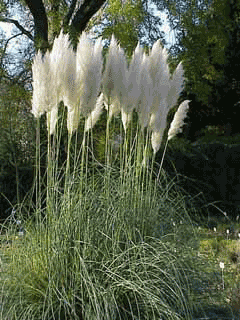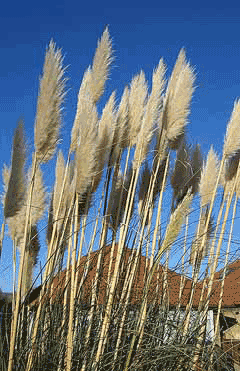 |
|
http://www.biolib.de/ |
 |
| http://commons.wikimedia.org/wiki/User:Solipsist Corydalis ambigua |
Translate this page:
Summary
Bloom Color: Pink, White.
Main Bloom Time: Early fall, Late summer, Mid summer, Mid fall. Form: Irregular or sprawling.
Physical Characteristics

 Cortaderia selloana is an evergreen Perennial growing to 3 m (9ft) by 1.2 m (4ft in) at a fast rate.
Cortaderia selloana is an evergreen Perennial growing to 3 m (9ft) by 1.2 m (4ft in) at a fast rate.
See above for USDA hardiness. It is hardy to UK zone 5 and is not frost tender. It is in leaf all year, in flower from August to October, and the seeds ripen from October to November. The species is dioecious (individual flowers are either male or female, but only one sex is to be found on any one plant so both male and female plants must be grown if seed is required). and is pollinated by Wind. The plant is not self-fertile.
Suitable for: light (sandy), medium (loamy) and heavy (clay) soils and prefers well-drained soil. Suitable pH: mildly acid, neutral and basic (mildly alkaline) soils. It cannot grow in the shade. It prefers dry or moist soil. The plant can tolerates strong winds but not maritime exposure.
UK Hardiness Map
US Hardiness Map
Synonyms
C. argentea. (Nees.)Stapf. Gynerium argenteum.
Plant Habitats
Lawn;
Edible Uses
References More on Edible Uses
Medicinal Uses
Plants For A Future can not take any responsibility for any adverse effects from the use of plants. Always seek advice from a professional before using a plant medicinally.
None known
References More on Medicinal Uses
The Bookshop: Edible Plant Books
Our Latest books on Perennial Plants For Food Forests and Permaculture Gardens in paperback or digital formats.

Edible Tropical Plants
Food Forest Plants for Hotter Conditions: 250+ Plants For Tropical Food Forests & Permaculture Gardens.
More

Edible Temperate Plants
Plants for Your Food Forest: 500 Plants for Temperate Food Forests & Permaculture Gardens.
More

More Books
PFAF have eight books available in paperback and digital formats. Browse the shop for more information.
Shop Now
Other Uses
Fibre Paper
A fibre obtained from the leaves is used for making paper[46, 61, 74, 189]. The leaves are harvested in the autumn, they are cut into usable pieces and soaked for 24 hours in clear water. They are then cooked for 2 hours with lye and then beaten in a blender. The fibre makes a yellow paper[189]. The feathery flower head plumes, when dried, are widely used in flower arrangements and other ornamental displays.
Special Uses
Carbon Farming
References More on Other Uses
Cultivation details
Agroforestry Services: Windbreak Industrial Crop: Biomass Management: Hay Minor Global Crop
Landscape Uses:Container, Massing, Specimen. Succeeds in most soils, preferring a damp well-drained sandy or loamy soil[1]. Inclined to be intolerant of cold clay soils[162]. Succeeds in dry soils. Prefers a sunny sheltered position[1, 162, 200]. Very tolerant of maritime exposure[K]. This species is hardy to about -20°c[187] if the winter is not excessively wet, though it is intolerant of prolonged periods of cold weather. Pampas grass is occasionally cultivated in some areas for its fibre which is used in making paper. Plants grow well as a focal point in a lawn and they also succeed in quite coarse grass[1, 233]. A number of named forms have been selected for their ornamental value[187, 200]. The leaves have saw-toothed edges, it is best to wear gloves when working with the plant[200]. Members of this genus are rarely if ever troubled by browsing deer or rabbits[233]. Dioecious. Male and female plants must be grown if seed is required[200]. The inflorescence on the male plant is rather erect whilst it has wide spreading branches on the female[187]. Special Features:Attracts birds, Attractive foliage, Not North American native, Suitable for cut flowers, Suitable for dried flowers, Attractive flowers or blooms.
Carbon Farming
-
Agroforestry Services: Windbreak
Linear plantings of trees and shrubs designed to enhance crop production, protect people and livestock and benefit soil and water conservation.
-
Industrial Crop: Biomass
Three broad categories: bamboos, resprouting woody plants, and giant grasses. uses include: protein, materials (paper, building materials, fibers, biochar etc.), chemicals (biobased chemicals), energy - biofuels
-
Management: Hay
Cut to the ground and harvested annually. Non-destructive management systems maintaining the soil organic carbon.
-
Minor Global Crop
These crops are already grown or traded around the world, but on a smaller scale than the global perennial staple and industrial crops, The annual value of a minor global crop is under $1 billion US. Examples include shea, carob, Brazil nuts and fibers such as ramie and sisal.
References Carbon Farming Information and Carbon Sequestration Information
Temperature Converter
Type a value in the Celsius field to convert the value to Fahrenheit:
Fahrenheit:
The PFAF Bookshop
Plants For A Future have a number of books available in paperback and digital form. Book titles include Edible Plants, Edible Perennials, Edible Trees,Edible Shrubs, Woodland Gardening, and Temperate Food Forest Plants. Our new book is Food Forest Plants For Hotter Conditions (Tropical and Sub-Tropical).
Shop Now
Plant Propagation
Seed - surface sow March/April in a greenhouse. The seed usually germinates in 2 - 3 weeks at 15°c. Keep the soil moist. The seed has a short viability[200]. When they are large enough to handle, prick the seedlings out into individual pots and grow them on in the greenhouse for at least their first winter. Plant them out into their permanent positions in late spring or early summer, after the last expected frosts. Division in late spring[1]. It can be very difficult to obtain divisions from this plant because they tend to be very large and to be very close to the main clump. We have found it best to use a sharp spade to cut into the main clump and break off the divisions. These are then potted up in light shade in a cold frame and are planted out once they have rooted well and are in active growth.
Other Names
If available other names are mentioned here
pampas grass; silver pampas grass; Uruguayan pampas grass.
Spanish: cortadera; ginerio plumacho; hierba da las pampas; penacho.
French: gynerion argente; herbe des pampas; roseau a plumes.
Brazil: bardeira; capim-do-pampas; paina; pluma.
Germany: Silberweisses Pampasgras.
Portugal: paina; plumas capim-das-pampas; ponacho-blanco erva-das-pampas.
Spain: carrizo de la pampa.
Native Range
SOUTHERN AMERICA: Brazil (Paraná, Rio de Janeiro, Rio Grande do Sul, Santa Catarina, São Paulo), Argentina, Chile, Uruguay
Weed Potential
Right plant wrong place. We are currently updating this section.
Please note that a plant may be invasive in one area but may not in your area so it's worth checking.
This plant can be weedy or invasive according. Listed as one of the worst invader taxa in Europe and as a noxious species in Western Australia. Invasive in Hawaii and California. In New Zealand and South Africa, the plant is banned from sale and propagation.
Conservation Status
IUCN Red List of Threatened Plants Status : This taxon has not yet been assessed.

Growth: S = slow M = medium F = fast. Soil: L = light (sandy) M = medium H = heavy (clay). pH: A = acid N = neutral B = basic (alkaline). Shade: F = full shade S = semi-shade N = no shade. Moisture: D = dry M = Moist We = wet Wa = water.
Now available:
Food Forest Plants for Mediterranean Conditions
350+ Perennial Plants For Mediterranean and Drier Food Forests and Permaculture Gardens.
[Paperback and eBook]
This is the third in Plants For A Future's series of plant guides for food forests tailored to
specific climate zones. Following volumes on temperate and tropical ecosystems, this book focuses
on species suited to Mediterranean conditions—regions with hot, dry summers and cool, wet winters,
often facing the added challenge of climate change.
Read More
Expert comment
Author
(Schult.&Schult.f.)Asch.&Graebn.
Botanical References
200
Links / References
For a list of references used on this page please go here
Readers comment